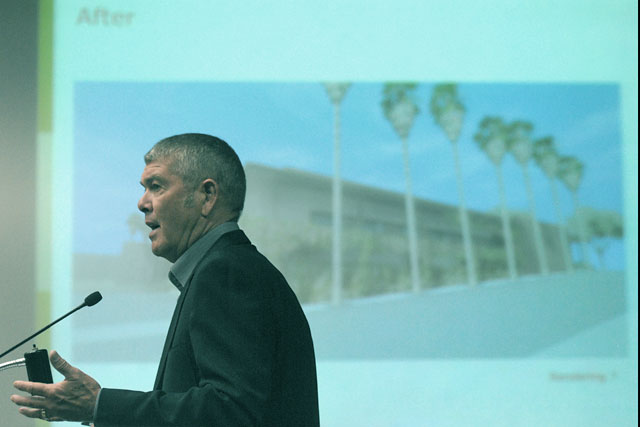Modernism Trumps Red Tiles
Mixed-Use Project with Rental Units Gets Thumbs-Up from Council

It may not have been the shoot-out at the O.K. Corral, but by Santa Barbara’s standards, it was probably the next best thing: an aesthetic showdown between the city’s Historic Landmarks Commission and the Architectural Board of Review over what constitutes “too modern” in front of the Santa Barbara City Council. At issue was the fate of a proposed mixed-use addition and remodel to a oversized utilitarian box of a state office building built in 1964 — at the intersection of Olive and Canon Perdido streets — that all sides agreed was painfully devoid of any redeeming architectural virtues. In the end, the council voted 6-1 to allow developer Peter Lewis to build in its place a drastically refurbished — and objectionably modern to some parties — four-story structure standing 51 feet off the ground offering both offices space and 19 one-unit and studio rental units.
Lewis’s proposal had been appealed by Grant Castleberg, who owns a home a block away and contended that the Architectural Board of Review (ABR) abdicated its core mission and responsibilities when it approved so modernistic a design within 200 feet of the boundaries of El Pueblo Viejo, where the historic and Hispanic design guidelines are rigorously enforced. Castleberg argued that Lewis should have opted for “a Mediterranean village” design, or failing that, “a contemporary Mediterranean village.” Castleberg was joined by several members of the Historic Landmarks Commission, who voiced similar objections, arguing that greater pains should have been taken to ensure the proposed new edifice be designed more in harmony with the city’s Red Tile aesthetics. One member, retired architect Don Sharpe, argued that ABR members were “totally out of touch” and hadn’t properly done their job after approving the Lewis proposal after four meetings.
Equally bristly was longtime affordable-housing advocate Mickey Flacks, who suggested Lewis’s critics were hiding their true objections behind “weaselly” concerns about neighborhood compatibility, and accused them of wanting to turn all of downtown Santa Barbara into “Pueblo Land.” While Flacks didn’t say so explicitly, her clear insinuation was that Lewis’s critics opposed the addition of 19 rental housing units into a residential neighborhood. All the project’s detractors, however, took pains to praise the proposal’s inclusion of rental housing, something all sides of the affordable-housing debate agree is urgently needed but which many private developers insist can’t be built without substantial subsidy.
Lewis said fully 80 percent of the other properties on his block were decidedly modern in their style, and argued that to be compatible with the neighborhood, he had to blend in. “To me, there was no alternative but to embrace the modernism that existed.” One of Lewis’s critics, a retired architect, took exception to the looseness with which the description “modern” was tossed about, insisting instead it was “just junk.” To help clarify just what the phrase meant, Lewis’s architect Mark Kirkhart explained that modern architecture celebrated “long, low horizontal lines punctuated by verticalities” and illustrated how his design embodied that spirit.
Some councilmembers appeared visibly uncomfortable at being tugged in opposite directions by members of the two committees. While Councilmember Cathy Murillo ultimately sided with Lewis and opposed the Castleberg appeal, she also said she was moved by “the passion” of the project’s critics and believed they were “pure of heart.” But she also insisted the members of the ABR were not “out of touch” and that they had “done their jobs.” Mayor Helene Schneider noted that the proposed redevelopment lay well outside the El Pueblo Viejo boundaries and argued it would be unfair to hold Lewis to a standard of design review not on the books. She praised Lewis for crafting plans such that his proposed new building would be invisible to the three historic structures located within 250 feet of the site. Only Councilmember Dale Francisco supported the Castleberg appeal. He argued that ABR should have exacted even greater concessions from Lewis in terms of building materials and colors so that his project blended in better with the surrounding neighbors.



